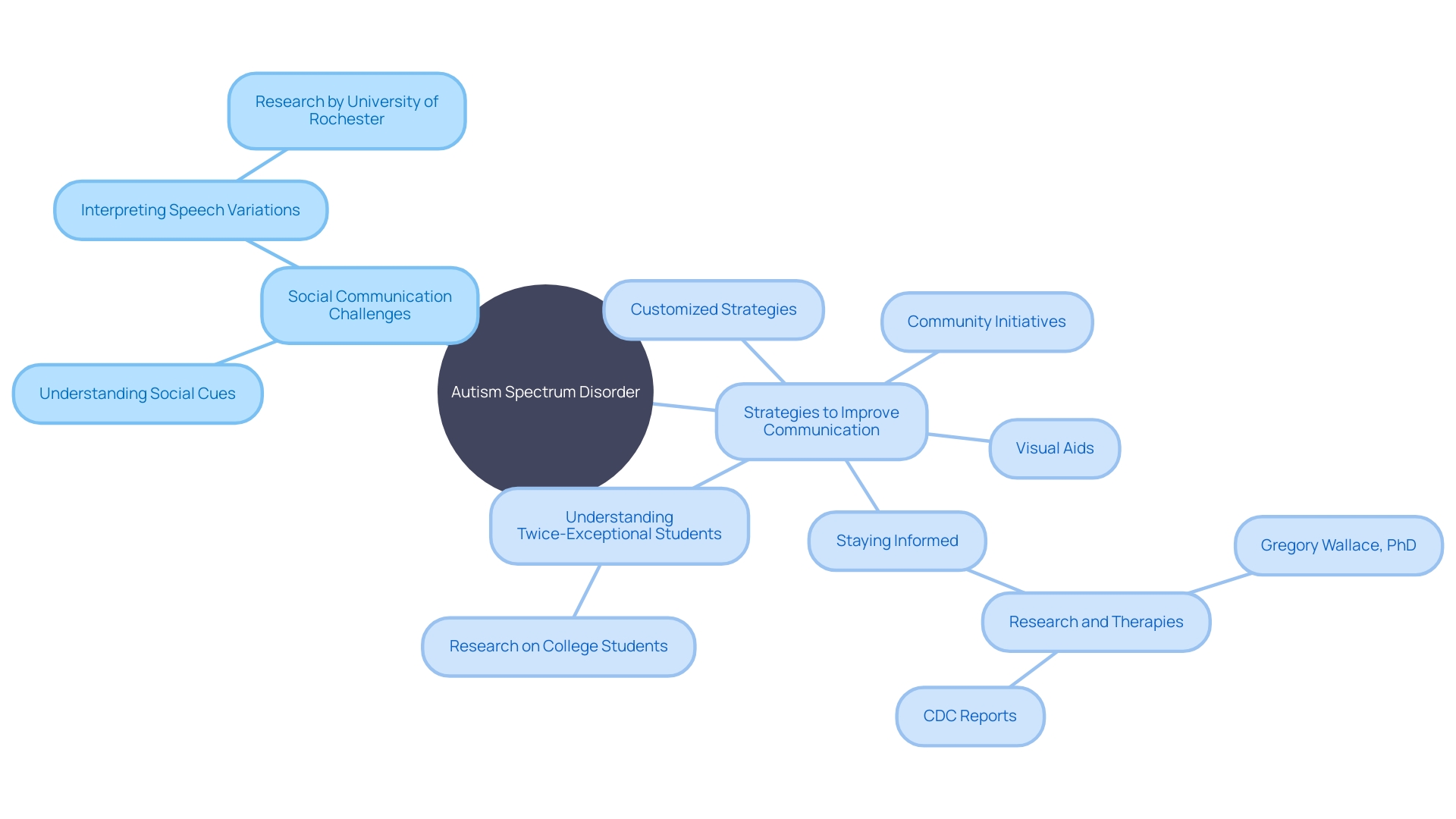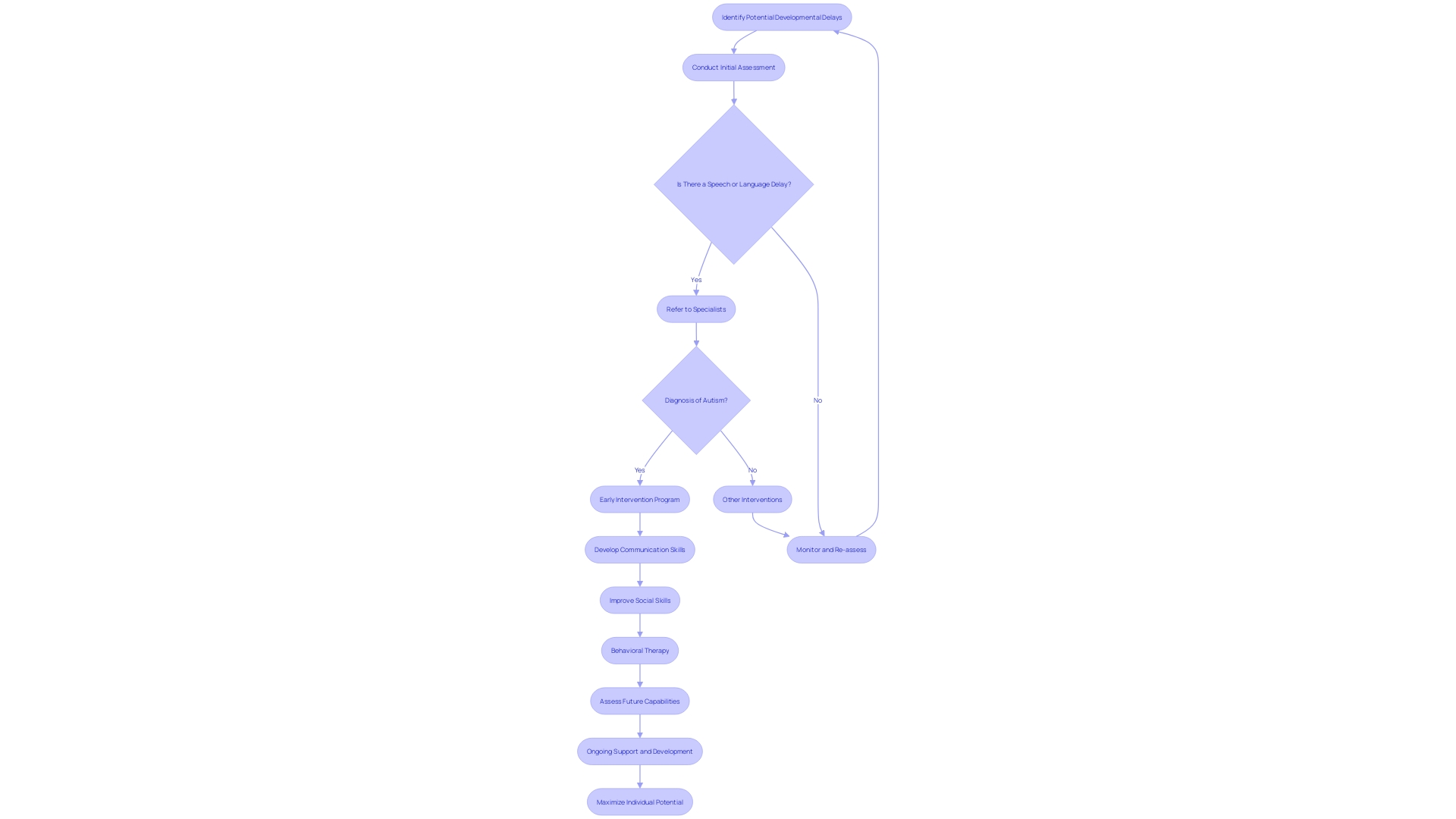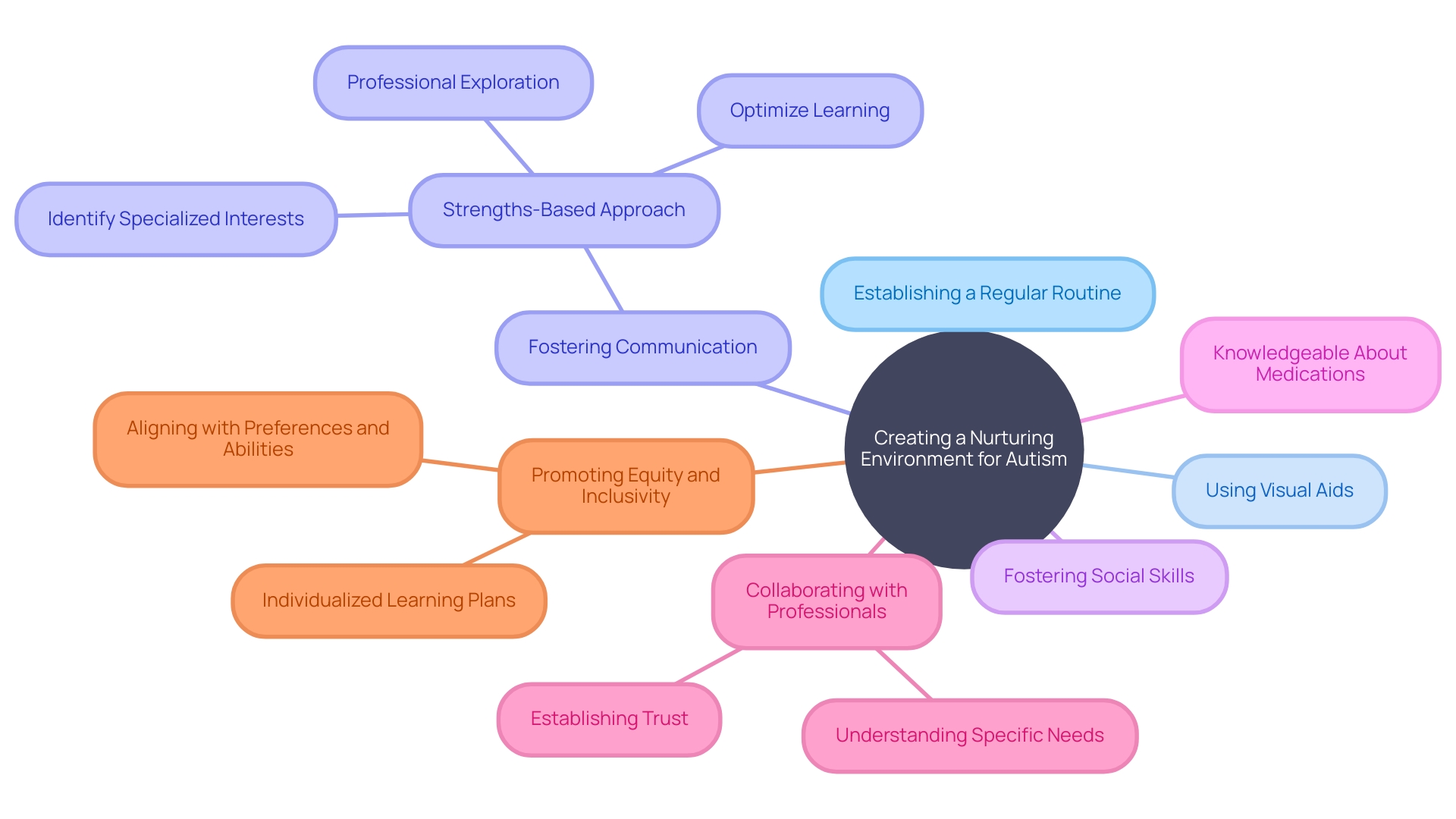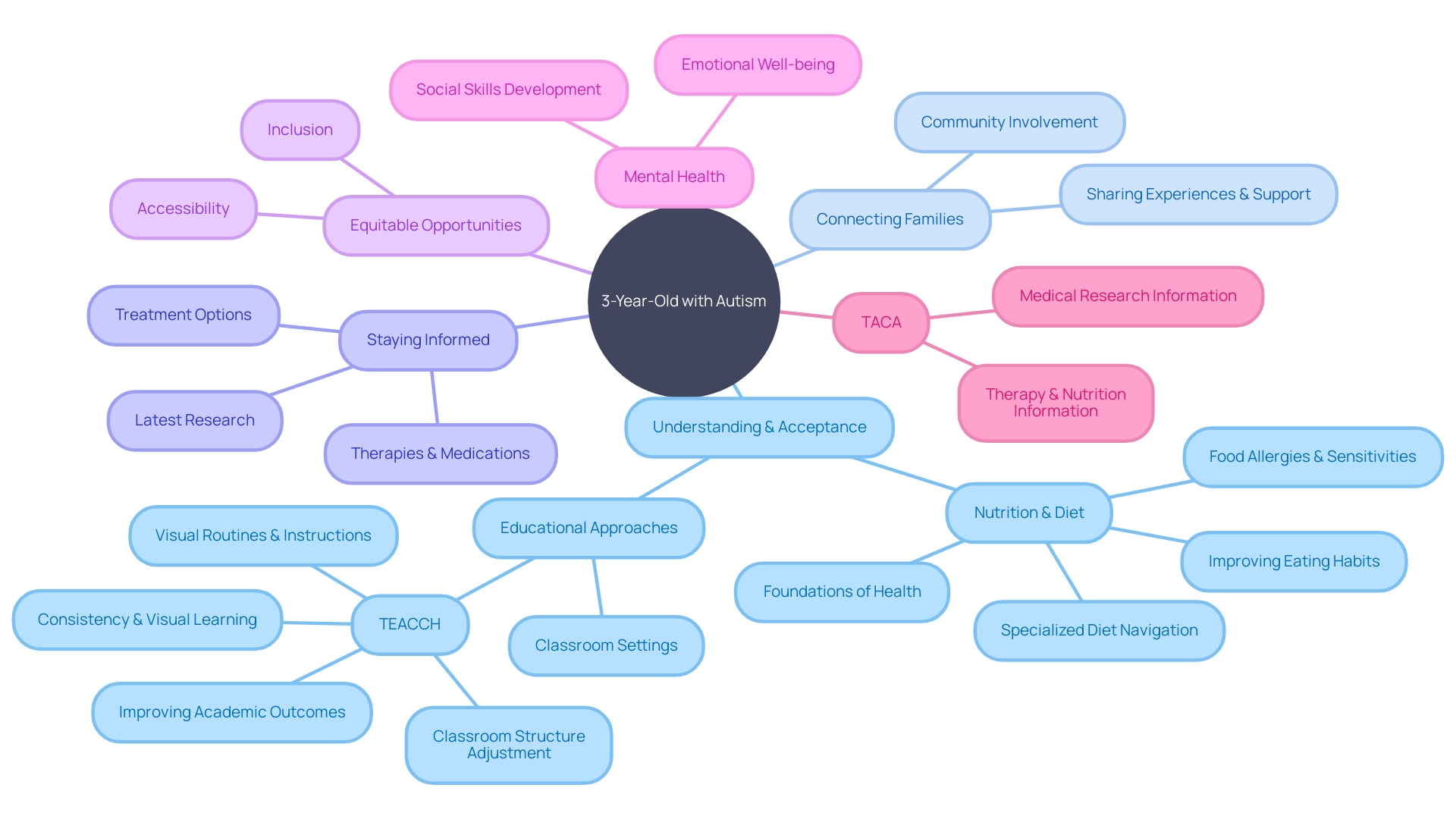Introduction
Recognizing the early signs of autism in 2-year-olds is crucial for their developmental journey. Reduced eye contact, limited speech, repetitive actions, and challenges in social interactions are indicators that can emerge as early as two years old. Early detection and personalized interventions are emphasized in recent research, highlighting the importance of tailored approaches to treatment.
Advances in diagnostic methods, such as the potential use of artificial intelligence, offer hope for early diagnosis and timely interventions. Parent advocates play a vital role in empowering parents through this process, providing resources and community support. By staying informed about developmental milestones and seeking support when concerns arise, parents can ensure that children with autism receive the comprehensive care they need to thrive.
Early Signs of Autism in 2-Year-Olds
Identifying the initial signs of autism spectrum disorder (ASD) in toddlers can be a significant aspect of a youngster's developmental journey. ASD, a condition that can become apparent in the early years of an individual's life, manifests through various behaviors and developmental cues. It's crucial for those caring for children to stay vigilant for signs such as reduced or infrequent eye contact, limited or absent speech, repetitive actions, or challenges during social interactions. These signs can emerge as young as two years old, and acknowledging them is the first step towards seeking professional guidance and support.
Recent research, including a study published in the Journal of Personalized Medicine, emphasizes the importance of early detection and personalized interventions in managing ASD. The study, which focused on 4-year-old dizygotic twins with level 3 severity of the condition, highlights the potential benefits of a non-pharmacological, tailored approach to treatment. This underscores the fact that while ASD symptoms can be similar, each child's experience with the disorder is unique, leading to the necessity for individualized support strategies.
As we move towards a greater understanding of ASD, we're also seeing advances in diagnostic methods. For example, a study reported by Medical Xpress suggests that artificial intelligence (AI) could play a role in the early diagnosis of a developmental disorder, potentially allowing for more timely interventions. Moreover, the understanding of ASD is becoming more nuanced, recognizing the diverse range of conditions within the autism spectrum, as noted by the World Health Organization on World Awareness Day for individuals with autism.
For parent advocates, the message is one of hope and action. Beth Lambert, a study author and founder of Epidemic Answers, articulates this sentiment clearly. She discusses the potential for reversing many conditions associated with ASD and emphasizes the availability of resources and community support to empower parents through the process. This progressive viewpoint is crucial as we continue to observe a growing occurrence of a certain condition among populations.
Essentially, prompt identification of the signs of ASD, combined with a knowledgeable and proactive approach to support, can have a significant impact on the lives of individuals with ASD and their families. By staying informed about developmental milestones and seeking support when concerns arise, parents and caregivers can help ensure that individuals with ASD receive the comprehensive care they require to thrive.
Social Communication Challenges
Social communication is a complex skill that typically develops early in life, but for individuals with autism spectrum disorder, like 2-year-olds, it can present unique challenges. These young ones might find it hard to participate in reciprocal interactions—think of the natural give-and-take in conversations or games—or might not respond when their names are called. They may also have difficulties interpreting and using nonverbal signals like facial expressions, which are crucial for silent communication. To improve the social skills of their offspring, parent advocates can create regular opportunities for their young ones to interact socially, perhaps through community initiatives similar to Friends of St James Park, which offers an inclusive environment for skill-building and networking. Visual aids can be invaluable, tool, for assisting individuals with autism comprehend and interact with the world around them. Working with professionals to customize strategies to the individual's needs is also a crucial step in promoting their social communication.
Autism doesn't prevent individuals from living engaged, supported, and fulfilling lives. With proper support, individuals with neurodevelopmental disorders can thrive in their homes, schools, and leisure activities, contributing to their mental health and overall well-being. It's important for caregivers to have access to the necessary resources to foster their offspring's development. As suggested by the Interagency Autism Coordinating Committee (IACC), a coalition that comprises members of the community affected by autism and governmental agencies, staying informed about new research and therapies is crucial. Furthermore, comprehending the subtleties of social cues, such as distinguishing between authentic and forced smiles, can assist parental advocates in directing their offspring through the intricacies of social engagement, guaranteeing that every individual, irrespective of impairment, can engage meaningfully in community.

Repetitive Behaviors and Restricted Interests
Understanding the unique behaviors and interests of 3-year-olds on the autism spectrum is crucial for creating a supportive environment. It is not uncommon for these individuals to engage in repetitive motions such as hand-flapping or rocking, or to develop intense fascinations with certain objects or subjects. To foster a nurturing space for growth, structuring a predictable routine can be invaluable. Introducing a variety of activities can also provide new avenues for engagement and learning. Moreover, seeking professional advice is key in addressing these behaviors effectively. Dr. David Offord's support for fair treatment of individuals with disabilities forms the basis of acknowledging and addressing the requirements of autistic individuals. As emphasized by the innovative MOBSE method, taking into account medical factors and nutritional deficiencies is crucial, particularly considering that individuals with autism are more prone to experiencing gastrointestinal issues. Efforts to support communication development, as initiated by Laura Kasbar with Gemini, further underscore the need for tailored support. Parental involvement, as observed by Dr. Heather Henderson, can have a substantial impact on a young person's capacity to control and cultivate executive functions. Grant programs such as the Kevin and Avonte Program, and state-specific Medicaid plans, provide targeted strategies to tackle the challenges faced by individuals with autism. Keep in mind, presenting autism in a positive manner is essential to prevent negative self-perceptions in youngsters. With the right resources and strategies, parents and advocates can empower these young individuals to thrive in their daily lives.
Sensory Sensitivities and Processing Differences
Autism, a spectrum condition with diverse manifestations, often presents with unique sensory processing challenges in young individuals. At three years of age, individuals with autism may show increased sensitivity or decreased responsiveness to sensory inputs. This can manifest as a strong reaction to certain sounds, textures, or lights, potentially leading to distress and influencing their behavior and well-being. To support these individuals, it is crucial to customize their surroundings to their sensory needs. This includes creating spaces that limit overwhelming stimuli, offering regular sensory breaks, and working with specialists to devise strategies that enable these individuals to navigate their world more comfortably. By comprehending the complexities of the tactile, proprioceptive, and vestibular systems, caregivers can offer the required interventions to enhance a young individual's growth and education efficiently.
Difficulty with Transitions and Routine Changes
For individuals on the autism spectrum, maintaining a predictable routine can be pivotal in managing daily life. This is particularly true for 3-year-olds, who may find it distressing when faced with unexpected changes or when transitioning between activities. To meet the needs of their children, caregivers can utilize visual schedules, which allow children to visually understand and anticipate upcoming activities, reducing the anxiety linked to uncertainty. Providing advanced notice before transitions can also prepare them for what's ahead, offering a gentle adjustment period.
Introducing changes incrementally allows young individuals to adapt at a comfortable pace, fostering resilience to new routines. As emphasized by Dr. Gregory Wallace of The George Washington University, understanding the unique experiences of autistic individuals is crucial, yet there is a gap in research about their adult years. This emphasizes the significance of providing caregivers with techniques to aid in the growth of young individuals.
Caregivers are also tasked with staying informed about new findings and treatment approaches, a continuous learning process that contributes to the well-being of their offspring. They play a critical role in understanding the benefits and risks of medications prescribed by doctors, vigilantly observing any changes in behavior. This extensive research and understanding are foundational to creating a supportive and equitable environment, as envisioned by Dr. David (Dan) R. Offord, who advocated for the fair and engaged inclusion of all individuals, including those with disabilities, in society.
By recognizing the unique strengths and needs of their offspring, parents can reduce stressors and support the healthy development of their offspring, aligning with the principle of supported decision-making, which encourages autonomy by allowing individuals to make informed decisions with the assistance of trusted supporters. This approach respects the individual's capacity for choice and participation in their own life, an essential aspect of growing up with a sense of self-agency and inclusion.
Importance of Early Intervention
Identifying the important stages of growth and development in a young individual is vital, particularly during the foundational years of infancy to young childhood. These milestones include social, emotional, language, cognitive, and physical skills. In the case of individuals with autism, intervention at a young age is crucial in assisting these areas of development. Studies show that 90% of brain development in young individuals happens before the age of 5, emphasizing the importance of initial experiences in molding their future capabilities. Intervening at the outset not only fosters improvements in communication and social skills but also positively influences behavior, setting the stage for a fair 'race' in life, as emphasized by Dr. David (Dan) R. Offord.
Research has moved towards randomized controlled trials to assess the effectiveness of interventions, ensuring that the assistance provided to individuals with autism is based on the most up-to-date evidence. The 'gold standard' for autism care encompasses behavioral interventions that offer individualized support, which can be integrated into daily family routines for a holistic approach. As we acknowledge the diverse needs and unique contributions of children with disabilities, it's essential to equip caregivers with the necessary resources to nurture their child's development. This dedication to high-quality, personalized programming and inclusion in childhood programs is a joint effort, involving States, local agencies, schools, and families. The closure of services such as Growing Early Minds emphasizes the requirement for access to alternative assistance and information, like family hubs, to continue providing this vital aid.
In brief, early intervention for kids with ASD is an investment in their future, guaranteeing that they receive the assistance they require to flourish in all areas of life. By comprehending and taking action on these developmental milestones, we can establish an inclusive and equitable environment that respects the potential of every individual.

Role of Parents in Monitoring Development
For parents of 3-year-olds with autism, vigilance in observing and documenting their offspring's development is crucial. Observing your offspring's behaviors, milestones, and overall progress not only contributes to a better understanding of their unique needs but also equips professionals with key insights for accurate diagnosis and effective intervention. It is crucial to document the developmental journey of your offspring, noting particulars and any deviations from expected milestones. Sharing these observations with healthcare providers ensures that any concerns are addressed promptly and that you, as a parent, are an integral part of the assessment and treatment plan.
Research, such as studies conducted by the UC Davis MIND Institute, highlight the significance of early detection in siblings of individuals with autism spectrum disorder, which can result in prompt intervention and improved outcomes. Furthermore, embracing open science principles, including sharing knowledge promptly, as seen during the pandemic's research collaborations, can greatly benefit the field of autism research. Efforts like those by Mr. Harris, who supported visual communication aids, showcase the transformative power of resources in improving communication for non-speaking individuals.
Furthermore, the dedication to guaranteeing equitable and supportive conditions for individuals with disabilities, as highlighted by Dr. David (Dan) R. Offord, corresponds with the role of parent advocates in promoting a fair environment for their children's growth. By addressing both unmet needs and recognizing the strengths children with ASD bring to their communities, parent advocates can reduce stress and advocate for the necessary resources to support their son's or daughter's and family's well-being.
Strategies for Supporting a 2-Year-Old with Autism
For parent advocates caring for young individuals with developmental disorder, staying informed about the latest developments in treatments and approaches is crucial. Creating a nurturing environment for a 3-year-old with autism involves more than just structure and routine; it demands continuous learning and adaptation. By establishing a regular routine and using visual aids such as storyboards, young individuals can better comprehend and navigate their world. Clear expectations and engaging activities are also key in fostering communication and social skills. It is important for parents to be knowledgeable about the medications prescribed to their offspring, comprehending the possible advantages and hazards, and monitoring any behavioral alterations. This knowledge empowers parents to make informed decisions about their offspring's health and to be critical of unverified online information. As research in autism is constantly evolving, parent advocates are encouraged to collaborate with professionals to create personalized strategies that make the most of their offspring's abilities while addressing their difficulties. Highlighting the significance of an equitable and nurturing setting, Dr. David (Dan) R. Offord's viewpoint serves as a reminder that every young individual, including those with ASD, merit the chance to flourish in their residences, educational institutions, and neighborhoods. The pursuit of equity for individuals diagnosed with autism emphasizes the significance of recognizing their unique contributions and reducing stressors that may hinder their development. By making sure that caregivers have the essential resources to support their offspring, we can promote a more inclusive and equitable society for all.

Creating a Supportive Environment
Creating a nurturing space for a 3-year-old with autism encompasses much more than mere awareness; it's about building a foundation of understanding and acceptance that permeates their entire environment. This involves leading family, friends, and caregivers towards an inclusive mindset, equipped with the knowledge and resources necessary to meet the individual's unique requirements. By establishing connections with other families following a comparable journey, parent advocates can exchange perspectives, provide reciprocal emotional support, and cultivate a community where the involvement of every individual is appreciated. As the Canadian Psychiatrist, Dr. David Offord, once expressed, 'I do not mind if my children are in a race as long as the race is fair.' This sentiment rings true in ensuring equitable opportunities for young individuals with autism to thrive within their homes, schools, and leisure activities—essentials for their mental health and the equity of the community. Research consistently unveils new insights into autism, such as the role of gut microbiota in a youngster's development, highlighting the importance of staying abreast of the latest findings. By staying alert to the advantages and drawbacks of emerging therapies and medications, caregivers can make educated choices, nurturing a setting where their offspring can thrive. It's a continuous journey of learning and adapting, but one that can be navigated successfully with dedication and the correct assistance.

Seeking Professional Evaluation and Support
For families navigating individuals with autism in young children, taking proactive steps toward engaging with the right support systems can be transformative. It's crucial to initiate professional evaluations for 2-year-olds displaying characteristics associated with autism, as early interventions like speech and occupational therapy, alongside applied behavior analysis (ABA), have been shown to significantly bolster a youngster's developmental trajectory. A pediatrician who specializes in the care of children is an excellent starting point for referrals to specialists in autism, ensuring access to tailored evaluation and intervention services that align with the latest research in autism care.
The recent shift in research on individuals with developmental differences, with a preference for randomized controlled trials over quasi-experimental studies, emphasizes the significance of evidence-based interventions. These scientific advances guide clinicians in selecting the most effective treatments, fostering an environment where every individual, including those with neurodevelopmental disorders, can fully participate in all life domains—school, home, and leisure. Such participation is not only a marker of mental health but also a measure of societal equity, as posited by the late Dr. David (Dan) R. Offord. His statement about not being concerned if his offspring are participating in a competition, as long as it is just, aligns with the continuous endeavors to create equal opportunities for individuals with disabilities, guaranteeing they are not marginalized.
In the aftermath of services like Growing Early Minds closing, parents and caregivers are urged to stay informed about new developments in the care of individuals with autism. Continuous learning about the benefits and potential risks of treatments and medications is paramount. Verification of information through expert consultation is essential, as not all treatments found online are beneficial or safe. As one parent advocate noted, "While the internet is a valuable source of research, it's important to verify information with experts and learn what to discount or ignore." This method protects against false information and guarantees that caregivers have the knowledge to effectively support their offspring's well-being.
Moreover, the efforts of the Interagency Autism Coordinating Committee (IACC) and dedication to guidelines such as the Early Years Foundation Stage (EYFS) framework demonstrate the joint commitment to supporting individuals with autism. By understanding and utilizing these resources, caregivers can ensure their children receive the most appropriate care, paving the way for a more inclusive and equitable society.
Conclusion
In conclusion, early recognition of autism signs in 2-year-olds is crucial for their development. Tailored interventions and advances in diagnostic methods, such as artificial intelligence, offer hope for early detection and timely support. Parent advocates play a vital role in empowering parents, providing resources and community support.
By staying informed about developmental milestones and seeking help when needed, parents can ensure that children with autism receive the comprehensive care they need to thrive. Strategies for social communication challenges, repetitive behaviors, sensory sensitivities, and difficulty with transitions are important for creating a nurturing environment.
Early intervention is key to improving communication, social skills, and behavior. Parent advocates should closely monitor their child's development, documenting behaviors and milestones to inform healthcare providers. Building an inclusive and supportive environment involves forming connections with other families and accessing professional evaluation and support.
Recognizing and addressing the unique needs of children with autism is essential. With the right resources and strategies, parents and advocates can empower these children to thrive and contribute to society. The commitment to an inclusive and equitable environment is a collective effort that benefits all.




